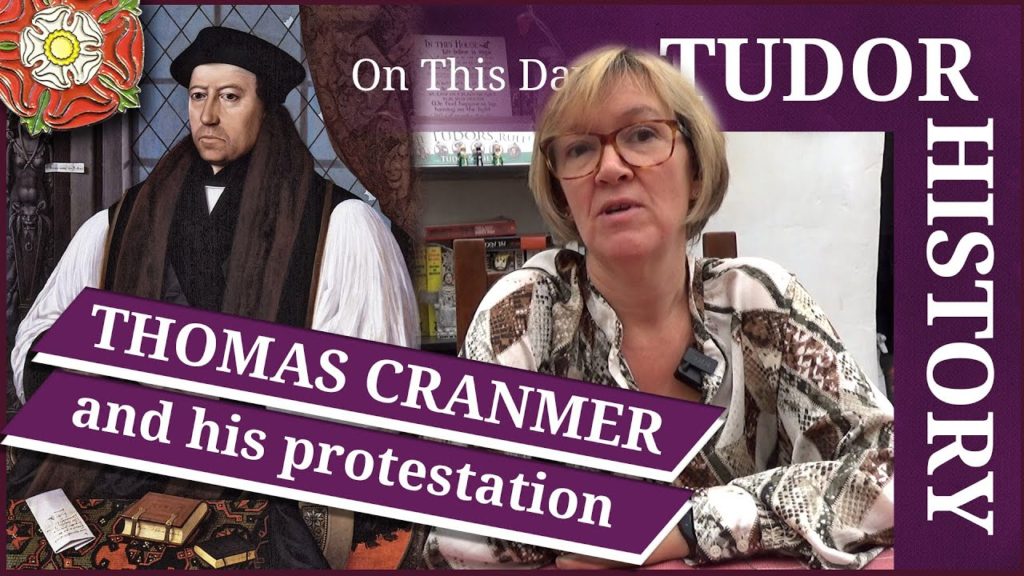On this day in Tudor history, 30th March 1533, at the Passion Sunday service, Thomas Cranmer, Archdeacon of Taunton, was consecrated as Archbishop of Canterbury.
His consecration was not like those of others before him, however, because as well as making the usual oath promising to be faithful to the papacy and to denounce heretics, he also made a protestation to show that his oath would not conflict with his loyalty to King Henry VIII and his commitment to reforming the church. Hmmmm.... complicated.
Find out more in today's talk.
Other videos on Thomas Cranmer:
Also on this day in Tudor history, 30th March 1558, Queen Mary I wrote her will. She did it because she believed that she was just about to give birth, and, obviously, childbirth was a risky process. Find out more about her will, and what happened with this “pregnancy”, in last year’s video:
Also on this day in history:
- 1555 – Burning of Protestant martyr, Robert Ferrar, Bishop of St David's, at Carmarthen. He had already been deprived of his bishopric because he violated the vow of chastity by marrying and was condemned after refusing to agree to articles presented to him, articles which he saw as having been drawn up by man and not by God. He went to his death with courage.
- 1587 – Death of Sir Ralph Sadler, at the age of nearly eighty. Sadler was a diplomat and administrator who worked as Cromwell's Secretary before being noticed by Henry VIII. At his death, he was one of the richest men in England.
Transcript:
30 March
On this day in Tudor history, 30th March 1533, at the Passion Sunday service, Thomas Cranmer, Archdeacon of Taunton, was consecrated as Archbishop of Canterbury by the Bishops of Lincoln, Exeter, and St Asaph in the church of St Stephen’s College, Westminster Palace.
Cranmer’s predecessor, William Warham, had died on 22nd August 1532.
Before he took the oath of obedience to the see of Rome, Cranmer made a ‘protestation’. He read it out before the consecration ceremony, in a private room in the Chapter House, in front of five officials and lawyers. In it, as historian Jasper Ridley explains, he “declared that he did not intend any oath to the pope which he took at his consecration to be binding if it was against the law of God, or against our illustrious King of England or the Commonwealth, the laws or prerogatives of his realm of England, or to bind him to be any less free to advise and agree to the reformation of the Christian religion, and of the government of the Church of England in any way which furthered the prerogative of the Crown.”
After he’d made his protestation, he was consecrated in the church, taking his consecration oath, in which he swore to be faithful to St Peter, to the Holy Roman Apostolic Church, and to the Pope. He also promised to protect the papacy and the church, to denounce heretics, schismatics and rebels, but the Archbishop also stated that his oath was subject to the protestation he’d made, which he then read out. This protestation’s aim was to show that the oath of obedience to the papacy that Cranmer took at his consecration would not be in conflict with his loyalty to Henry VIII and his commitment to reforming the Christian religion.
Cranmer also swore his allegiance to King Henry VIII and swore that he did “renounced and utterly foresake all such clauses, words, sentences and grants which I have of the Pope’s holiness in his bulls of the archbishopric of Canterbury, that in any manner was, is or may be hurtful or prejudicial to your Highness, your heirs, successors, estate or dignity royal.”
Cranmer was Archbishop of Canterbury until December 1555, in the reign of Queen Mary I, when Papal sentence was passed on him, depriving him of his archbishopric “and of all ecclesiastical dignities” and giving permission to the secular authorities in England to decide on his fate. He had been tried for heresy and found guilty. He was burnt at the stake on 21st March 1556. Cardinal Reginald Pole replaced him as Archbishop of Canterbury on 22nd March 1556.
